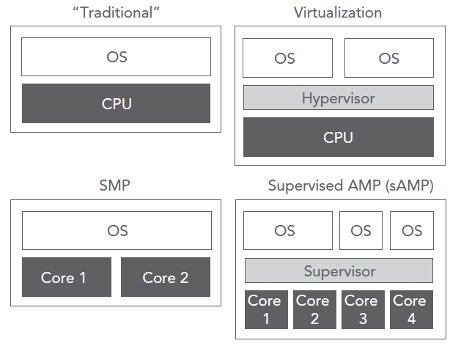Wind River Hypervisor adds Cortex-A9, Windows 7 support
Sep 7, 2011 — by Eric Brown — from the LinuxDevices Archive — 13 viewsWind River announced a new version of its Linux-ready Wind River Hypervisor virtualization software, ready for both ARM Cortex-A9 architectures and Windows 7. Wind River Hypervisor 1.3 also adds an internal Ethernet switch, SR-IOV-based PCI Express device isolation on Intel platforms, plus the ability to migrate virtual machines between CPU cores to save power, says the company.
Wind River Hypervisor was updated to version 1.2 in Oct. 2010, adding support for the Intel Xeon 5600 series and Freescale's PowerPC-based QorIQ P2 and P4 system on chips (SoCs). Hypervisor 1.2 also added a device management layer and automated software upgrades.
The Type 1 embedded hypervisor, which is aimed primarily at multicore virtualization, previously supported Linux as well as its VxWorks real-time operating system and other RTOSes. The software provided deep integration with its own Wind River Linux and VxWorks distributions.
Now Microsoft Windows 7 support has been added, and Windows XP is said to be supported as well, according to the Intel subsidiary. (See farther below for more background on Wind River Hypervisor.)

Multicore configuration options on Wind River Hypervisor 1.3
(Click to enlarge)
While the processors are known for their role in Android-based consumer electronics devices ranging from smartphones to tablets, the Hypervisor/Cortex-A9 pairing will primarily benefit companies in the industrial and medical market segments, says Wind River. Wind River Hypervisor will give developers the ability to run real-time applications alongside human machine interface (HMI) applications on Cortex-A9-based systems, resulting in workload consolidation, says the company.
New features target NEPs
Other new Hypervisor 1.3 features are aimed at increasing scalability for network equipment providers (NEPs). For starters, using Hypervisor, NEP developers can now "dynamically" create virtual machines and migrate them between CPU cores to save power, says Wind River.
Other networking oriented features include a new internal Ethernet switch. The switch lets users create isolated internal networks and inter-virtual machine communication through standards-based protocols, says the company.
On Intel architecture, NEPs can now take advantage of PCI Express device isolation and partitioning based on new PCI-SIG SR-IOV compliance. The feature is said to offer the ability to share Ethernet devices among multiple virtual machines while maintaining hardware access speeds.
Wind River background
Wind River Hypervisor is designed to enable embedded developers replace multiple boards or CPUs with a single board or CPU, thereby saving on cost and power consumption, says Wind River. Developers can also use the technology to create devices that leverage multiple operating systems (OSes), and reduce complexity when integrating multicore processors, says the company.
The technology is billed as a Type-1 ("bare metal") hypervisor supporting real-time features including fast performance, low latency, determinism, and minimal footprint. Wind River Hypervisor offers protection between OSes and cores, and is capable of starting, stopping, and reloading OSes for increased reliability, says the company. The technology is said to support Symmetric Multiprocessing (SMP), Asymmetric Multiprocessing (AMP), and supervised AMP architectures.
By offering guaranteed separation and isolation, Wind River Hypervisor can support functions requiring safety certification by government and regulatory bodies, such as IEC-61508 certification, says Wind River. It also provides for security-certified workloads running alongside other workloads, thereby reducing certification costs, claims the company.
In addition to being optimized for Wind River Linux and VxWorks, Wind River Hypervisor is also said to be highly integrated with the Wind River Workbench Eclipse IDE and the Wind River Test Management test automation framework.
According to Wind River, VDC Research Group named Wind River Hypervisor the embedded virtualization market leader in its 2011 "Virtualization for Mobile and Embedded Systems" report. Wind River Hypervisor was said to have achieved the highest share of the embedded virtualization market in 2010 with greater than 30 percent of total market revenue.
Availability
Wind River Hypervisor 1.3 is available now, says Wind River. More information may be found at the Wind River Hypervisor 1.3 product page.
This article was originally published on LinuxDevices.com and has been donated to the open source community by QuinStreet Inc. Please visit LinuxToday.com for up-to-date news and articles about Linux and open source.